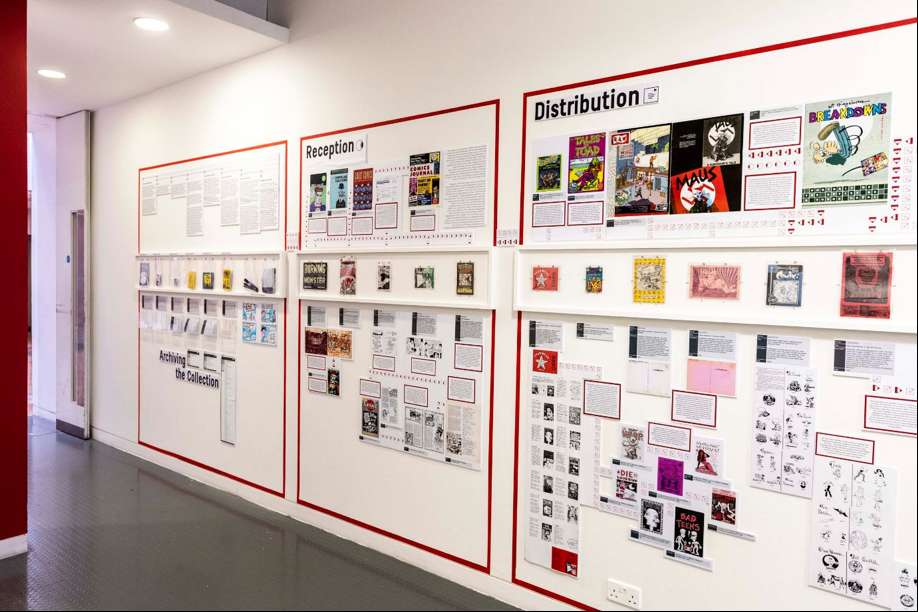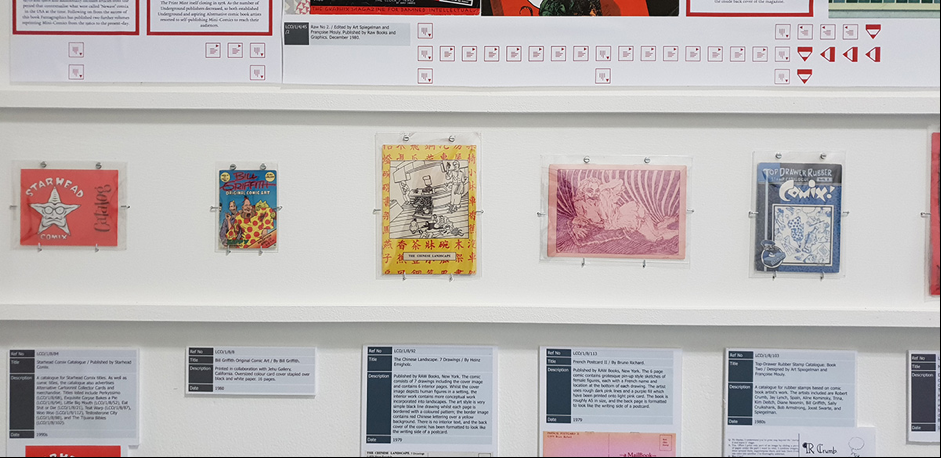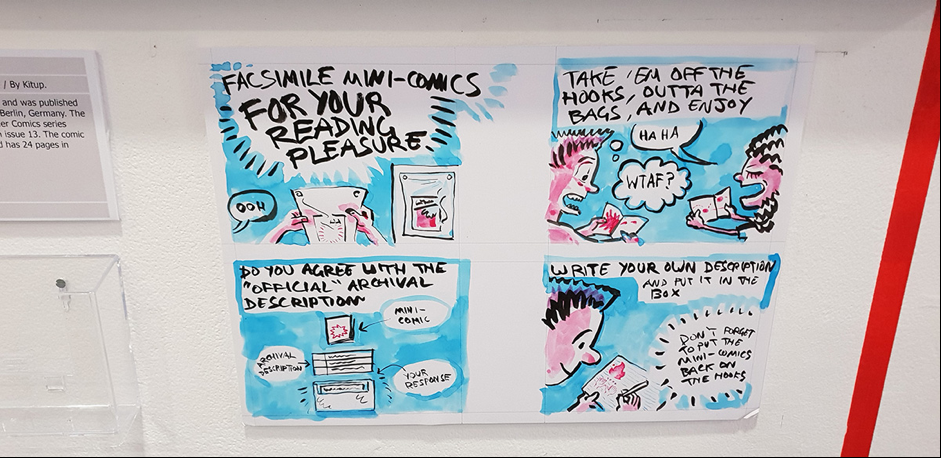
Georgina Orgill, Assistant Manager and Stanley Kubrick Archivist, Archives and Special Collections Centre, University of the Arts London
The University Archives and Special Collections Centre worked with academics from London College of Communication to showcase and highlight part of our collection of alternative and underground comic books in an exhibition - Into/Out of the Box - held as part of the London Design Festival 2018. The exhibition celebrated a part of what is a significant and under-researched collection, but also aimed to foreground a critical approach to archives cataloguing and the way in which this affects archives users. It provided a catalyst for archives staff and academic staff to think about this issue, and provides a starting point for future projects on the same theme.
archives; special collections; cataloguing; exhibition; graphic narratives
In September and October 2018, the Archives and Special Collections Centre (ASCC) of the University of the Arts London worked with academics from London College of Communication (LCC). Dr Ian Horton, Dr Ian Hague, Dr Nina Mickwitz and Dr John Miers worked with the ASCC to showcase and highlight part of our collection of alternative and underground comic books for an exhibition at LCC, held as part of the London Design Festival. The exhibition, Into/Out of the Box, was part of LCC Design School’s show Everything Happens So Much (LCC, 2018). The exhibition functioned as a way to celebrate and highlight what is a significant and under-researched collection, but in addition to this, it aimed to foreground a critical approach to cataloguing archives and the way in which this affects how that archive is used. This case study is intended to support those introducing students to archival research and researchers who use archive catalogues to locate material.
Much has been written about the part that archives play in creating and shaping historical narratives, and by extension, the role that archivists themselves play in selecting which collections and archives are preserved. Bias in collecting has been recognised and discussed in recent writings on archival appraisal. In 1977 Howard Zinn wrote that ‘the archivist, even more than the historian and the political scientist, tends to be scrupulous about his neutrality […] [but] the archivist, in subtle ways, tends to perpetuate the political and economic status quo simply by going about his ordinary business.’ (Zinn, 1977, p.20). Increasingly, writers and theorists look at ‘archival appraisal’ through a post-modern lens. In an influential and often cited essay, Randall Jimerson writes that ‘[f]ar from being a neutral repository for recorded memory, archives (and archivists) actively mediate and shape the historical record’ (Jimerson, 2003, p. 92). He points out that archivists ‘consciously decide to shape the archival record, even when we do not realise we are doing so.’ (ibid, p. 93). Elizabeth Kaplan notes that archives are ‘major players in the business of construction and identity politics’ (Kaplan, 2000, p.147). To correct the effects of archival bias in collecting, Terry Cook argues that archivists should ‘ask whom and what they are excluding from archival memorialization’ and then create strategies to rectify the situation (Cook, 2001, p.30).
Whilst the issues around what is kept are well documented, the practicalities of what is catalogued, and how, has received less critical attention. This is despite the fact that online catalogues are the main point at which archival researchers gain access to materials. As Nesmith observes, ‘few researchers can simply plunge into the vast amounts of archives and just start reading without this guidance’ (Nesmith, 2002, p.37). Anna McNally writes that ‘[r]esearchers are used to questioning the implicit bias in a first-hand source but usually take the objectivity of archival description for granted’ (McNally, 2013, p.107). Yet the archival descriptions which mediate a user’s experience of material are written by archivists often working to catalogue a collection with limited resources and who are not usually experts in the subject area of the archive they are cataloguing.
Archival cataloguing is also governed and restricted by internationally agreed standards for cataloguing. In the UK and at the ASCC, archival cataloguing is done in accordance with the International Standard for Archival Description, known as ISAD(G) (ICA, 1999). This standard covers the way in which archives are arranged, but also the way in which they are described. It considers certain information to be mandatory in any catalogue record, and also offers guidance on writing descriptions. ISAD(G) has itself been the focus of debate, but this has mainly centred on its directions on arrangement and its choice of metadata (Bearman, 1992, p.33). In accordance with ISAD(G), archivists, as much as possible, write ‘neutral’ descriptions of objects. We try to be comprehensive but concise, avoiding subjective descriptions and providing enough information to make the user able to see whether or not the material described will be relevant to their research.
Material is catalogued hierarchically, so that descriptions proceed from general to specific. Usually there will be a collection-level description covering the entirety of the archive, with the archive then further divided into groups of records which share a common function: these are called series. Series can then be further divided into files, and files into items, with each level of catalogue record providing a more detailed, narrower focus. However, in practice, time constraints mean that many archives, or parts of an archival collection, are not catalogued at file and item level. Our need to ensure that an entire archive is catalogued enough to be useable, and the catalogue made available to researchers, means that often we have to prioritise, choosing which material is catalogued in more detail. This in turn influences how visible material is to researchers, affecting what material is researched.
The Les Coleman Archive is a collection of underground and alternative comic books compiled by Les Coleman, an artist and illustrator who died in 2012. The collection covers 40 linear metres of material, and includes significant collections of the work of Robert Crumb, Aleksander Zograf and Julie Doucet as well as single-issue comics, anthologies and artworks in other formats. It also includes his own personal papers, research materials, correspondence with comic book artists and draft comics created by him. The collection contains possibly the largest collection of the work of Robert Crumb in Europe, but despite this it has until recently been relatively under-researched. The exhibition was in part an attempt to highlight the collection to potential researchers.
When speaking to the academics about their own and their students’ experiences of using the archive’s online catalogue, we realised that in many cases the ways in which the catalogue was interpreted and seen by users was worthy of a special focus. Students had reported to the academics that they found the ISAD(G)-compliant, neutral catalogue descriptions ‘dry’ and impersonal, and the hierarchical arrangement confusing – it seemed that the catalogue was off-putting to a key audience. Further, only some parts of the Les Coleman Archive had been catalogued to file or item level. The mini-comics series chosen to exhibit was in the process of being catalogued at item level. A significant collection of comic books which were often published on a very small scale, the mini-comics were chosen partly to highlight the collection, but also because of the fact that cataloguing had only very recently occurred, which made them an ideal series to highlight the issues around archival cataloguing.

The exhibition’s design and layout therefore sought to foreground the catalogue in the viewer’s mind. It consisted of reproductions of some of the mini-comics, original mini-comics which were securely displayed, and highly accurate facsimiles. The captions for each comic book were the catalogue descriptions written for the item; they were displayed with other catalogue information such as the reference number, and the caption retained the visual look of the cataloguing system used by the archive (Axiell CALM). One of the exhibition panels explained the process of archival cataloguing, and the history of cataloguing this particular part of the archive. It emphasised the fact that the cataloguing of the material happened gradually, over a period of more than one year, and the effect this had on the searchability and therefore research use of parts of the archive. Through this, visitors to the exhibition were able to see the ‘behind the scenes’ of the archive centre – we aimed to deconstruct and lay bare the complex process of prioritisation, research and writing that goes into something as ostensibly objective as an archival catalogue.

As well as deconstructing the process of cataloguing, the exhibition allowed visitors to participate in the cataloguing of material. Facsimiles of six of the comic books in the collection were made in order to allow any visitor to the exhibition to pick up and read through the comics. These were displayed alongside their caption (the catalogue description) and a box attached to the wall, with blank catalogue cards on which visitors could write their own descriptions (see Figure 3, below). We had a very good response to this, and these user-generated descriptions are hugely varied and very different to the neutral tone of the catalogue. They provide an alternative description and way of viewing and interpreting the material at hand and allow visitors to the exhibition (many of them UAL students) to direct and influence the catalogue. The intention is that we will utilise any pertinent information from these user-generated descriptions and add it to the archive catalogue itself.

Alongside the exhibition, we ran several comics handling sessions, which were held in the Atrium gallery adjacent to the exhibition itself. This allowed visitors to see and handle original comics (something which feedback from students often tells us is the most popular and engaging use of material). Through offering the chance to engage with archive material outside of the archive itself, we were also able to engage with students and visitors who might not visit the archive centre.
At a basic level, the exhibition has ensured that the collection itself is highlighted to new users. The exhibition is portable, as it can be installed in a small space and the use of facsimiles means that it can be displayed in venues which would not normally meet the criteria for a loan of archival material (due to issues with temperature and humidity controls or security, for example).
Perhaps more than this though, the exhibition has proved a catalyst for new ways of thinking about archival processes. It provided a way to bring these complexities into our engagement with users of the ASCC. These processes are often oblique, yet they hugely affect which material researchers are able to use. Prior to this exhibition, staff had not engaged students with archival cataloguing beyond explaining to them how to use the catalogue to request materials. The necessity of cataloguing in compliance with international standards means that our cataloguing style must remain the same. However, through highlighting the behind the scenes work that goes into archival cataloguing we have challenged the image of the catalogue as a neutral, objective source of information, encouraging exhibition visitors to think critically about the entire experience of research in an archive. They start to realise how such research might be affected, or even directed, by the archivists processing the collection. This reveals the process behind cataloguing the collection and allows users to contribute their own experiences and knowledge, democratising the archival process. The exhibition allowed users to become co-creators of catalogue descriptions.
The collaboration between academic staff and archives staff is one which will continue, and we intend to develop workshops which highlight to students the ways in which archivists affect their research and use of material. In this sense, the exhibition marks the beginning of a new way of thinking about archives – questioning not just the materials we hold, but how these materials are presented to users.
Bearman, D. (1992) 'Documenting documentation' in Archivaria, 34, pp.33–49. Available at: https://archivaria.ca/index.php/archivaria/article/view/11839/12791 (Accessed: 10 April 2019).
Cook, T. (2001) 'Fashionable nonsense or professional rebirth? Postmodernism and the practice of archives', Archivaria, 51, pp.14–35. Available at: https://archivaria.ca/index.php/archivaria/article/view/12792/13989 (Accessed: 10 April 2019).
International Council on Archives, ICA (1999) ISAD(G): general international standard for archival description, second edition. Ottawa: ICA. Accessed at: https://www.ica.org/en/isadg-general-international-standard-archival-description-second-edition (Accessed: 10 April 2019).
Jimerson, R. (2003) ‘Archives and memory’, OCLC Systems and Services, International Digital Library Perspectives, 19(3), pp.89–95. https://doi.org/10.1108/10650750310490289. (Accessed: 10 April 2019).
Kaplan, E. (2000) ‘We are what we collect, we collect what we are: archives and the construction of identity’, American Archivist, 63(1), pp.126–151. https://doi.org/10.17723/aarc.63.1.h554377531233l05. (Accessed: 10 April 2019).
London College of Communication, LCC (2018) Into/Out of the Box. Curated by Ian Horton, John Miers, Ian Hague, Nina Mickwitz and Georgina Orgill. Part of LCC Design School Everything Happens So Much and London Design Festival, LCC, London, 15 and 17–22 September. https://www.londondesignfestival.com/event/everything-happens-so-much (Accessed: 10 April 2019).
McNally, A. (2013) ‘All that stuff! Organising records of creative processes’ in Vakim, J, Stuckey, K. and Lane, V. (eds.) All This Stuff: Archiving the Artist. Faringdon: Libri Publishing, pp.97–108.
Nesmith, T. (2002) ‘Seeing Archives: Postmodernism and the Changing Intellectual Place of Archives, The American Archivist, 65(1), pp. 24-41. Available at: https://americanarchivist.org/doi/pdf/10.17723/aarc.65.1.rr48450509r0712u (Accessed: 10 April 2019).
Zinn, H. (1977) ‘Secrecy, archives and the public interest’, Midwestern Archivist, 2(2), pp.14–26. Available at: https://www.jstor.org/stable/41101382 (Accessed: 10 April 2019).
Georgina Orgill is the Stanley Kubrick Archivist and Assistant Manager at the University Archives and Special Collections Centre at University of the Arts London. She gained her MA in Archives and Records Management from University College London in 2015, and has worked in local authority, business and higher education archives. She is a unit tutor for MA Culture, Criticism and Curation at Central Saint Martins, introducing students to archival theory and cataloguing. She also works with the university’s Academic Support Online team to run workshops engaging students across UAL with archive collections.